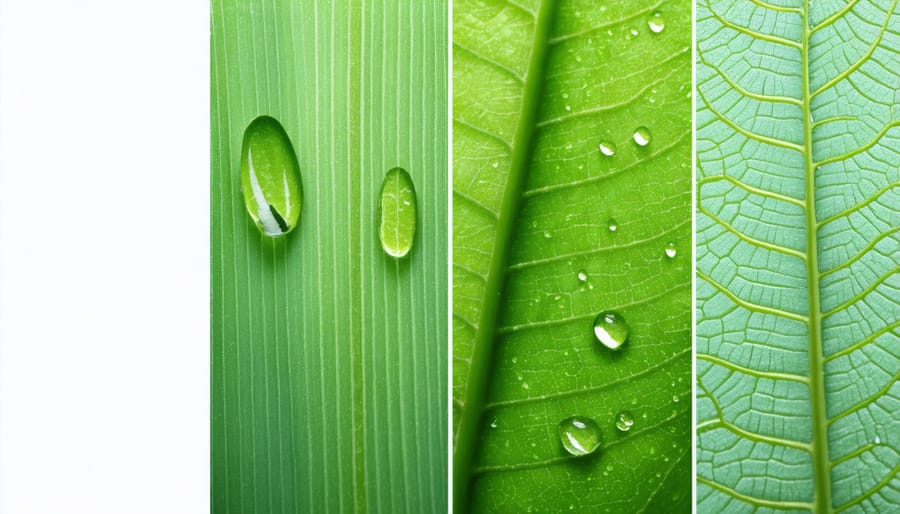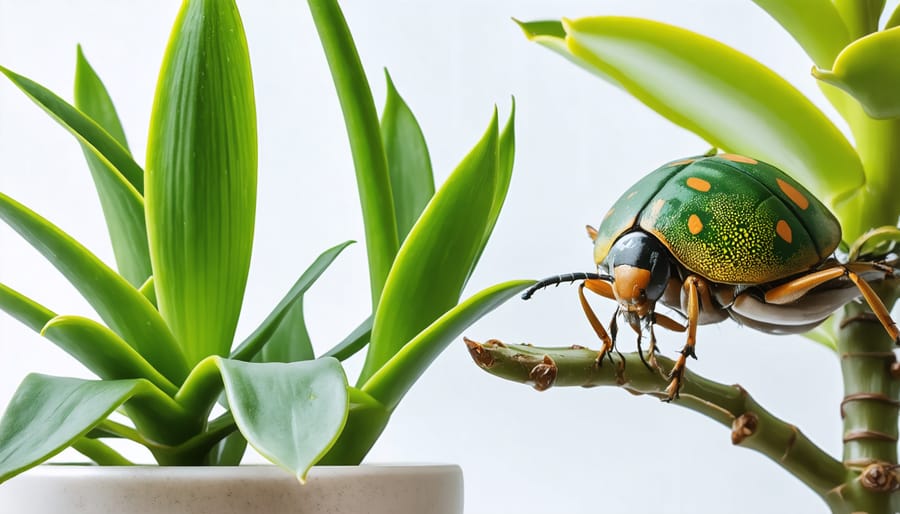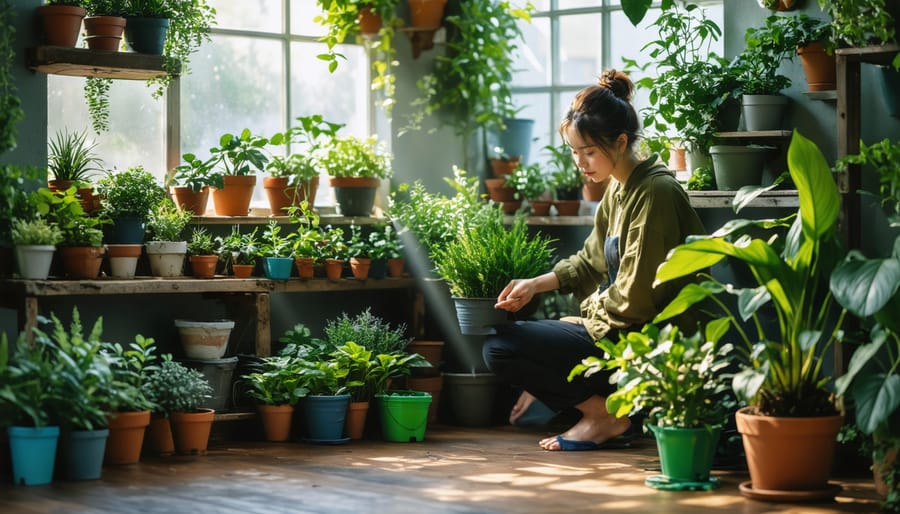Transform your living space into a thriving indoor jungle by mastering the essential indoor garden setup basics. Position plants strategically near windows based on their light requirements – bright indirect light for flowering varieties, low light for hardy pothos and ZZ plants. Monitor soil moisture with the finger test: insert your finger one inch deep, water only when dry. Maintain optimal humidity levels between 40-60% using pebble trays or small humidifiers, especially for tropical varieties. Choose well-draining pots with drainage holes and high-quality potting mix specifically formulated for indoor plants. Success with houseplants isn’t about green thumbs – it’s about understanding these fundamental care principles and creating the right environment for each plant to thrive. Whether you’re nurturing a single succulent or cultivating an entire indoor forest, these time-tested practices ensure your plants flourish year-round.
Understanding Your Indoor Environment
Light Requirements
Light is one of the most crucial factors in understanding indoor light requirements for your houseplants. Most indoor spaces offer three main types of lighting conditions: bright, medium, and low light. Bright light areas are typically within 3 feet of south or west-facing windows, where plants receive direct sunlight for several hours daily. Medium light zones are found near east-facing windows or 3-6 feet away from south/west windows, offering gentle morning sun or filtered light throughout the day.
To assess your space, observe how shadows fall throughout the day. If you can see a crisp shadow, you have bright light; a soft, fuzzy shadow indicates medium light; and barely visible shadows suggest low light conditions. Consider seasonal changes too – winter months bring shorter days and less intense light, while summer offers longer, brighter days.
If your space doesn’t provide ideal lighting, don’t worry! You can supplement natural light with grow lights or choose plants that match your existing light conditions. Remember that most plants can adapt to slightly less light than ideal, but few can thrive with too much or too little.

Temperature and Humidity
Most indoor plants thrive in environments that mimic their natural habitats, making temperature and humidity control essential for their well-being. The ideal temperature range for most houseplants is between 65-75°F (18-24°C) during the day, with a slight drop at night being perfectly acceptable.
Keep your plants away from cold drafts near windows and doors during winter, as well as direct air from heating vents or air conditioners. Sudden temperature changes can stress your plants, causing leaf drop or yellowing.
Humidity is equally crucial, with most indoor plants preferring levels between 40-60%. Modern homes often have dry air, especially during winter months when heating is in use. To increase humidity, try clustering plants together, using pebble trays filled with water, or running a humidifier nearby. Misting can provide temporary relief but isn’t a long-term solution for humidity-loving plants.
Monitor your plants’ responses to their environment – curling leaves often indicate low humidity, while brown leaf tips might suggest the air is too dry. By maintaining consistent temperature and appropriate humidity levels, you’ll create a comfortable environment where your indoor plants can flourish.
Watering Wisdom
Signs of Over and Under-Watering
Recognizing water-related issues early can save your indoor plants from serious damage. When it comes to overwatering, watch for yellowing leaves that feel soft and mushy, particularly on the lower parts of the plant. The soil might have a sour smell, and you may notice mold growing on the surface. Another telltale sign is when leaves start dropping even though they look healthy and green.
Underwatering shows different symptoms. Look for crispy, brown leaf edges and wilting that doesn’t improve after watering. The soil will feel dry and may pull away from the sides of the pot. Leaves might become brittle and fall off, while growth typically slows or stops completely.
To check if your plant needs water, stick your finger about an inch into the soil. If it feels dry at that depth, it’s usually time to water. For most plants, it’s better to underwater than overwater, as they can usually bounce back from drought stress more easily than root rot.
Remember that different plants have different water needs. Some, like succulents, prefer to dry out completely between waterings, while tropical plants might need consistently moist (but not wet) soil. Pay attention to your plant’s specific needs and adjust your watering schedule accordingly. During winter, most plants need less frequent watering as their growth naturally slows down.

Watering Schedules and Methods
Establishing a proper watering routine is crucial for your indoor plants’ health. Rather than following a rigid schedule, learn to read your plants’ needs by checking the soil moisture with your finger. Insert it about an inch deep into the soil – if it feels dry at that depth, it’s time to water.
Most indoor plants prefer thorough watering until water runs through the drainage holes, followed by a period of slight soil drying. This method encourages deeper root growth and prevents water-logging. However, avoid letting water sit in the saucer for more than 30 minutes.
The frequency of watering varies depending on several factors: season, humidity levels, pot size, and plant type. During growing seasons (spring and summer), plants typically need more frequent watering than in dormant periods. Plants in bright locations or heated rooms may need water more often than those in cooler, shadier spots.
Consider using self-watering systems for consistent moisture levels, especially when you’re away. Bottom watering is another effective method – place your pot in a container of water for 15-20 minutes, allowing the soil to absorb moisture from below. This technique promotes even water distribution and stronger root systems.
Remember that overwatering is more common than underwatering. When in doubt, it’s better to wait an extra day than to water too frequently.
Soil and Nutrition
Choosing the Right Potting Mix
The foundation of healthy indoor plants starts with the right potting mix. While garden soil might seem like a convenient choice, it’s too dense for container plants and can lead to drainage issues. Instead, opt for quality indoor potting mixes that provide the perfect balance of nutrients, aeration, and moisture retention.
For most houseplants, a well-draining, peat-based potting mix works wonderfully. These mixes typically contain a blend of peat moss, perlite, and vermiculite, creating an ideal environment for root growth. Succulents and cacti, however, need a faster-draining mix with added sand or grit to prevent root rot.
If you’re growing tropical plants like monstera or philodendron, look for mixes with added orchid bark and charcoal. These ingredients improve drainage while maintaining humidity around the roots. For plants that prefer acidic soil, such as peace lilies and African violets, specialty mixes are available with adjusted pH levels.
Consider making your own mix by combining two parts regular potting soil, one part perlite, and one part coconut coir. This creates a versatile blend that works well for most indoor plants while being cost-effective and environmentally friendly.
Fertilization Basics
Just like us, plants need their nutrients to thrive, and feeding them properly can make all the difference in their growth and appearance. For most indoor plants, fertilizing every 4-6 weeks during the growing season (spring and summer) is ideal. However, reduce or stop fertilizing during fall and winter when plant growth naturally slows down.
Choose a balanced, water-soluble fertilizer with an NPK ratio around 10-10-10 or 5-5-5 for general houseplants. Always follow the package instructions, as over-fertilizing can harm your plants more than under-fertilizing. A good rule of thumb is to dilute the fertilizer to half the recommended strength.
Before fertilizing, ensure the soil is slightly moist – never feed dry plants as this can damage their roots. Apply the fertilizer solution evenly around the base of the plant, avoiding direct contact with leaves or stems. If you notice white crusting on the soil surface or leaf tips turning brown, you might be over-fertilizing.
Some plants, like succulents and cacti, need less frequent feeding, while heavy feeders like monstera and pothos might benefit from monthly applications during growing season. Always observe your plants’ response and adjust accordingly.
Common Problems and Solutions

Pest Management
Even the healthiest indoor plants can occasionally face unwanted visitors. Learning to identify common houseplant pests early can save your green friends from serious damage. Keep an eye out for tiny specks moving on leaves, sticky residue, or unexplained leaf damage – these are often the first signs of pest problems.
Spider mites, scale insects, and mealybugs are among the most common indoor plant pests. When dealing with plant mites, start by isolating affected plants to prevent spread. A simple solution of mild soap and water can work wonders for many pest problems – just spray the leaves thoroughly, including the undersides.
For natural pest control, try neem oil, which is both effective and safe for indoor use. Regular inspection of your plants, especially new additions to your collection, can help catch issues before they become severe. Maintain good air circulation and avoid overwatering, as pests often thrive in humid, stagnant conditions.
If you spot white fuzzy patches (mealybugs) or brown bumps on stems (scale), use a cotton swab dipped in rubbing alcohol to remove them. For persistent problems, consider introducing beneficial insects like ladybugs, which naturally control pest populations without harmful chemicals. Remember, healthy plants are naturally more resistant to pests, so maintaining proper care routines is your best preventive measure.
Disease Prevention
Keeping your indoor plants disease-free starts with prevention. Always inspect new plants before bringing them home, and quarantine them for a week to ensure they’re healthy. Look for common signs of trouble: yellowing leaves, brown spots, wilting, or unusual growth patterns.
If you notice white, powdery patches on leaves, you’re likely dealing with powdery mildew. Improve air circulation and reduce humidity to combat this common issue. For fungal infections, which often appear as dark spots with yellow halos, remove affected leaves and avoid overhead watering.
Root rot is particularly sneaky because it starts below the soil. If your plant seems wilted despite proper watering, gently remove it from its pot and check the roots. Healthy roots should be firm and light-colored; dark, mushy roots indicate rot. Trim away affected areas and repot in fresh, well-draining soil.
For pest-related diseases, regularly inspect leaf undersides and stem joints. Spider mites leave tiny webs, while mealybugs appear as white, cottony clusters. A solution of mild soap and water can effectively treat most pest problems when caught early.
Remember, healthy plants resist disease better. Maintain proper watering schedules, ensure good airflow, and keep leaves dust-free. If you’re unsure about a plant’s condition, isolate it from others until you can properly identify and treat the problem.
Seasonal Care Tips
Just like the changing seasons outside, your indoor plants need adjustments to their care routine throughout the year. During spring and summer, most houseplants enter their active growing phase, requiring more frequent watering and fertilizing. This is the perfect time to maximize limited growing space by positioning plants near windows to catch the longer daylight hours.
As autumn approaches, gradually reduce watering frequency and stop fertilizing. Most plants naturally slow their growth during this time, and overwatering can lead to root problems. Move sensitive plants away from drafty windows and ensure they’re not touching cold glass panes.
Winter requires special attention to humidity levels, as indoor heating can create dry conditions that stress your plants. Using a humidity tray or running a humidifier can help maintain the moisture your plants need. Be mindful of shorter daylight hours and consider rotating your plants regularly to ensure even growth. Some plants may need to be moved closer to light sources, but watch for cold drafts from windows.
Temperature fluctuations can be particularly challenging during seasonal transitions. Keep plants away from heating vents in winter and air conditioning units in summer. Most houseplants prefer consistent temperatures between 65-75°F (18-24°C).
Remember that even tropical plants experience natural growth cycles. Don’t be alarmed if your plants seem less vigorous during winter months – this is normal, and they’ll bounce back when spring returns. Focus on maintaining consistent care routines while making gentle adjustments to water, light, and humidity as the seasons change.
Congratulations on taking the first steps toward becoming a successful indoor plant parent! Remember, every green thumb starts somewhere, and with the knowledge you’ve gained from this guide, you’re well-equipped to create a thriving indoor garden. The key is to start small, observe your plants regularly, and adjust your care routine based on their responses.
Don’t be discouraged if you face some challenges along the way – even experienced gardeners learn something new every day. Focus on mastering the basics: proper watering, appropriate lighting, and maintaining optimal humidity. Pay attention to your plants’ signals, and you’ll develop an intuitive understanding of their needs over time.
Whether you’re nurturing a single pothos or managing a jungle of tropical beauties, remember that indoor gardening is a rewarding journey that brings nature’s beauty into your home while improving air quality and creating a more peaceful living space. Start applying these care tips today, and watch your indoor garden flourish with confidence and joy. Happy growing!




